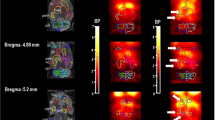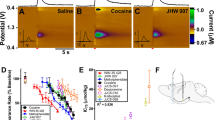Abstract
THE involvement of central dopaminergic neurones in the pathogenesis of several extrapyramidal movement disorders is well documented1,2. Moreover it has been suggested that dopaminergic mechanisms may also be involved in the physiological mechanisms underlying psychoses3. For these reasons there is considerable neuropharmacological interest in the interaction between anti-Parkinsonian and neuroleptic drugs and central dopaminergic systems. Recently it has been shown that homogenates of tissues containing dopaminergic synapses respond to low concentrations of dopamine by an increased production of cyclic AMP. These areas include the bovine superior cervical ganglion4, the rat and bovine retina5, rat basal ganglia6, olfactory tubercle, nucleus accumbens7 and cortex8. The effects of dopamine in some of these systems are mimicked by dopamine receptor stimulating drugs such as apomorphine6,7 and 1-(3,4-dihydroxybenzyl)-4-(2-pyrimidyl) piperazine (S584)9 and antagonised by neuroleptic drugs6,10–12. It seems, therefore, that these systems represent valid models of CNS dopamine receptors and it has been suggested that they may even comprise the dopamine receptor itself6. We have studied the dopamine-sensitive adenyl cyclase of the rat striatum in order to define some of the structural requirements for dopamine receptor agonists.
This is a preview of subscription content, access via your institution
Access options
Subscribe to this journal
Receive 51 print issues and online access
$199.00 per year
only $3.90 per issue
Buy this article
- Purchase on Springer Link
- Instant access to full article PDF
Prices may be subject to local taxes which are calculated during checkout
Similar content being viewed by others
References
Klawans, H. L., jun., The Pharmacology of Extrapyramidal Movement Disorders (Karger, Basel, 1973).
Carlsson, A., Acta neurol. scand., suppl. 51, 11–42 (1972).
Matthysse, S., Fedn. Proc., 32, 200–205 (1972).
Greengard, P., McAfee, D. A., and Kebabian, J. W., in Advances in cyclic nucleotide research vol. 5, 337–357 (Raven Press, New York, 1972).
Brown, J. H., and Makman, M. H., Proc. natn. Acad. Sci. U.S.A., 69, 539–543 (1972).
Kebabian, J. W., Petzold, G. L., and Greengard, P., Proc. natn. Acad. Sci. U.S.A., 69, 2145–2149 (1972).
Horn, A. S., Cuello, A. C., and Miller, R. J., J. Neurochem., 22, 265–270 (1974).
Von Hungen, H., and Roberts, S., Eur. J. Biochem., 36, 391–401 (1973).
Miller, R. J., and Iversen, L. L., Naunyn-Schmiedebergs Arch. exp. Path. Pharmac., 282, 213–216 (1974).
Miller, R. J., and Iversen, L. L., Trans. Biochem. Soc., 2, 256–259 (1974).
Miller, R. J., and Iversen, L. L., J. Pharm. Pharmac., 26, 142–144 (1974).
Brown, J. H., and Makman, M. H., J. Neurochem., 21, 477–479 (1973).
Klein, D. F., and Davis, J. M., in Diagnosis and Treatment of Psychiatric Disorders, 74 (Williams and Wilkins, Baltimore, 1969).
Goldberg, L. I., Sanneville, P. F., and NcNay, J. L., J. Pharmac. exp. Ther., 163, 188–197 (1968).
Woodruff, G. N., and Walker, R. J., Int. J. Neuropharmac., 8, 279–289 (1969).
Bergin, R., and Carlstrom, D., Acta Cryst., B 24, 1506–1510 (1968).
Bustard, T. M., and Egan, R. S., Tetrahedron, 27, 4457–4469 (1971).
Giesecke, J., Acta Cryst., B 29, 1785–1791 (1973).
Rekker, R. F., Engel, D. J. C., and Nys, G. C., J. Pharm. Pharmac., 24, 589–591 (1972).
Kier, L. B., and Truitt, E. B., J. Pharmac. exp. Ther., 174, 94–98 (1970).
Horn, A. S., and Snyder, S. H., Proc. natn. Acad. Sci. U.S.A., 68, 2325–2328 (1971).
Cannon, J. G., Kim, J. C., Aleem, M. A., and Long, J. P., J. med. Chem., 15, 348–350 (1972).
Woodruff, G. N., Comp. Gen. Pharmac., 2, 43P (1971).
Pinder, R. M., Buxton, D. A., and Woodruff, G. N., J. Pharm. Pharmac., 24, 903–904 (1972).
Glowinski, J., and Iversen, L. L., J. Neurochem., 13, 655–669 (1966).
Brown, B. L., Ekins, R. D., and Albano, J. D. M., in Advances in cyclic nucleotide research, vol. 2 (edit. by Greengard, P., and Robinson, G. A.), 25–40 (Raven Press, New York, 1972).
Author information
Authors and Affiliations
Rights and permissions
About this article
Cite this article
MILLER, R., HORN, A., IVERSEN, L. et al. Effects of dopamine-like drugs on rat striatal adenyl cyclase have implications for CNS dopamine receptor topography. Nature 250, 238–241 (1974). https://doi.org/10.1038/250238a0
Received:
Revised:
Issue Date:
DOI: https://doi.org/10.1038/250238a0
This article is cited by
-
Culture requirements for optimal expression of 1α,25-dihydroxyvitamin D3-enhanced thyrotropin secretion
In Vitro Cellular & Developmental Biology - Animal (1991)
-
Dopamine stimulates production of cyclic AMP by the salivary gland of the cockroach,Nauphoeta cinerea
Cellular and Molecular Neurobiology (1982)
-
α-Adrenergic agents. 3. Behavioral effects of 2-aminotetralins
Psychopharmacology (1982)
Comments
By submitting a comment you agree to abide by our Terms and Community Guidelines. If you find something abusive or that does not comply with our terms or guidelines please flag it as inappropriate.



